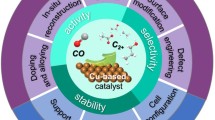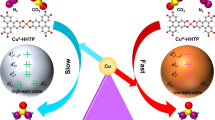Summary.
The catalytic action of Cu(II) on the decomposition of H2O2 in near-neutrality aqueous solutions is activated by halide ions. The activation energies amount to 113±7 (parent reaction) and 69.9±1.4 (chloride-activated reaction) kJ · mol−1. Free-radical chain mechanisms are proposed for both the parent reaction and the halide-activated reaction. The catalyst activation caused by halide ions is explained in terms of coordination of halide ligands by both Cu(II) and Cu(I), the coordination causing a higher stabilization of Cu(I) than of Cu(II). At low concentrations, Br− causes an inhibition of the Cu(II)/H2O2 reaction. This is explained in terms of an increase of the rate of termination of the chain reaction due to the scavenging effect of OH radicals caused by Br−.
Similar content being viewed by others
Author information
Authors and Affiliations
Additional information
Received March 27, 2001. Accepted (revised) May 25, 2001.
Rights and permissions
About this article
Cite this article
Perez-Benito, J. Copper(II)-Catalyzed Decomposition of Hydrogen Peroxide: Catalyst Activation by Halide Ions. Monatshefte für Chemie 132, 1477–1492 (2001). https://doi.org/10.1007/s007060170004
Issue Date:
DOI: https://doi.org/10.1007/s007060170004




